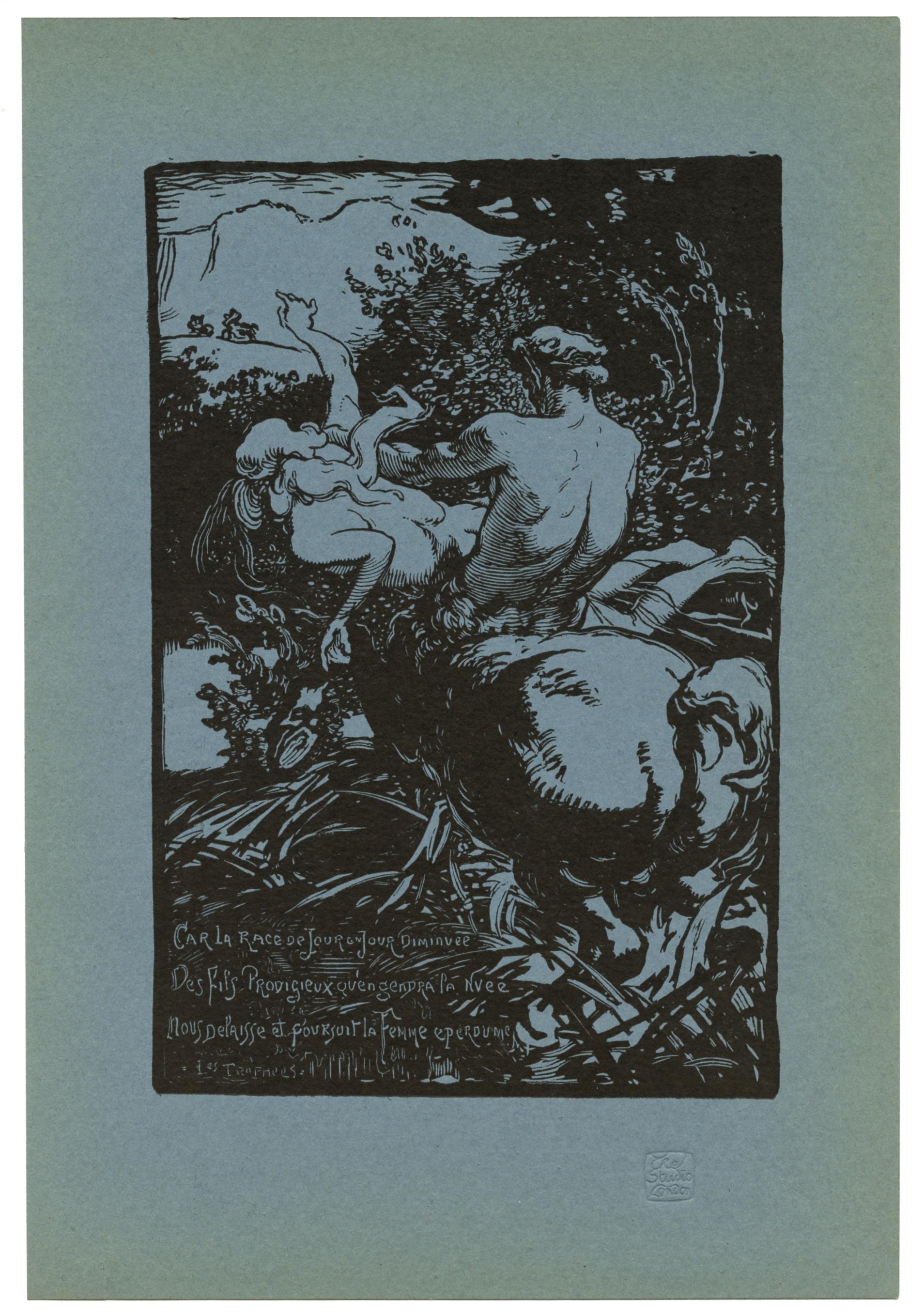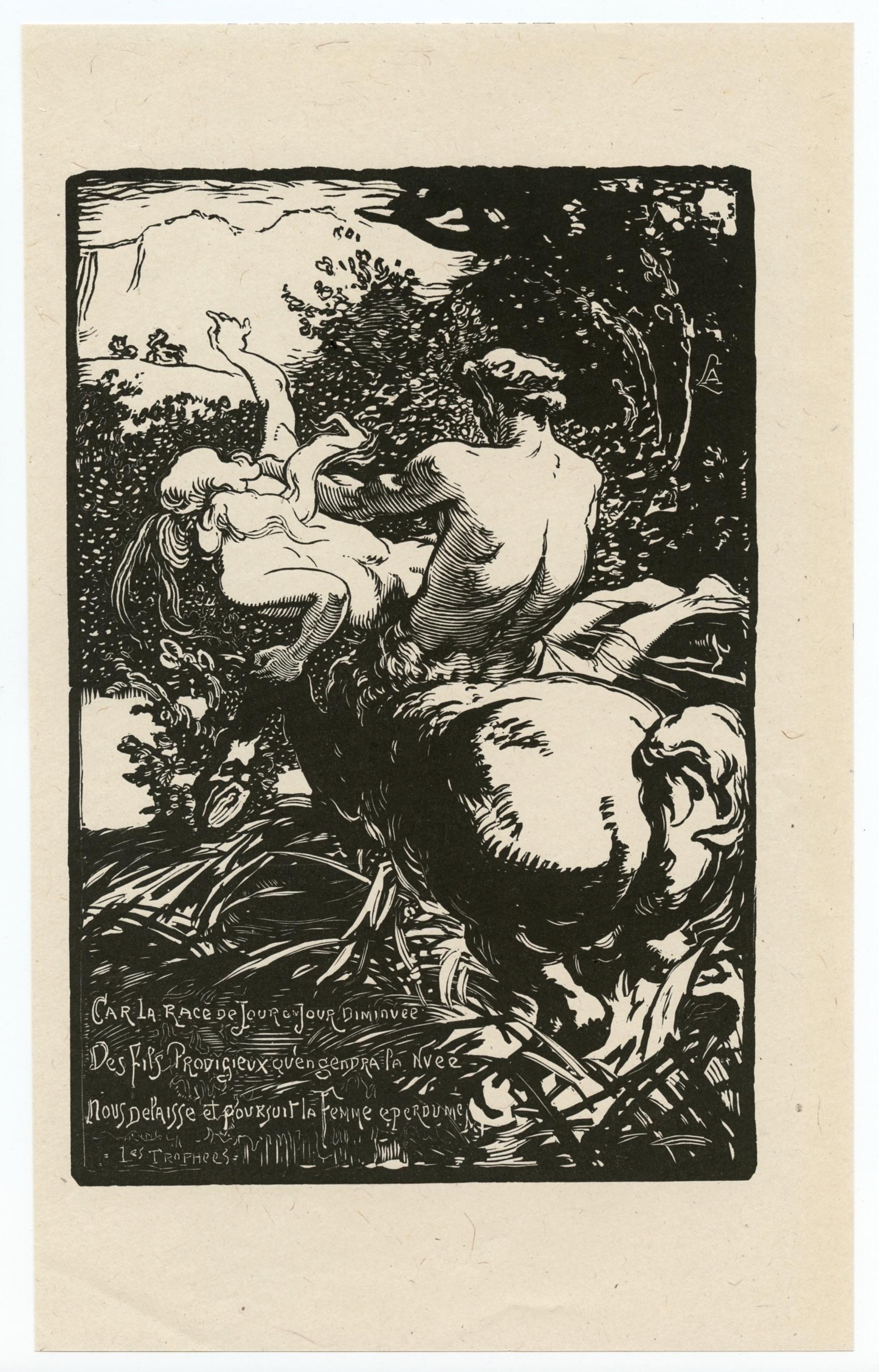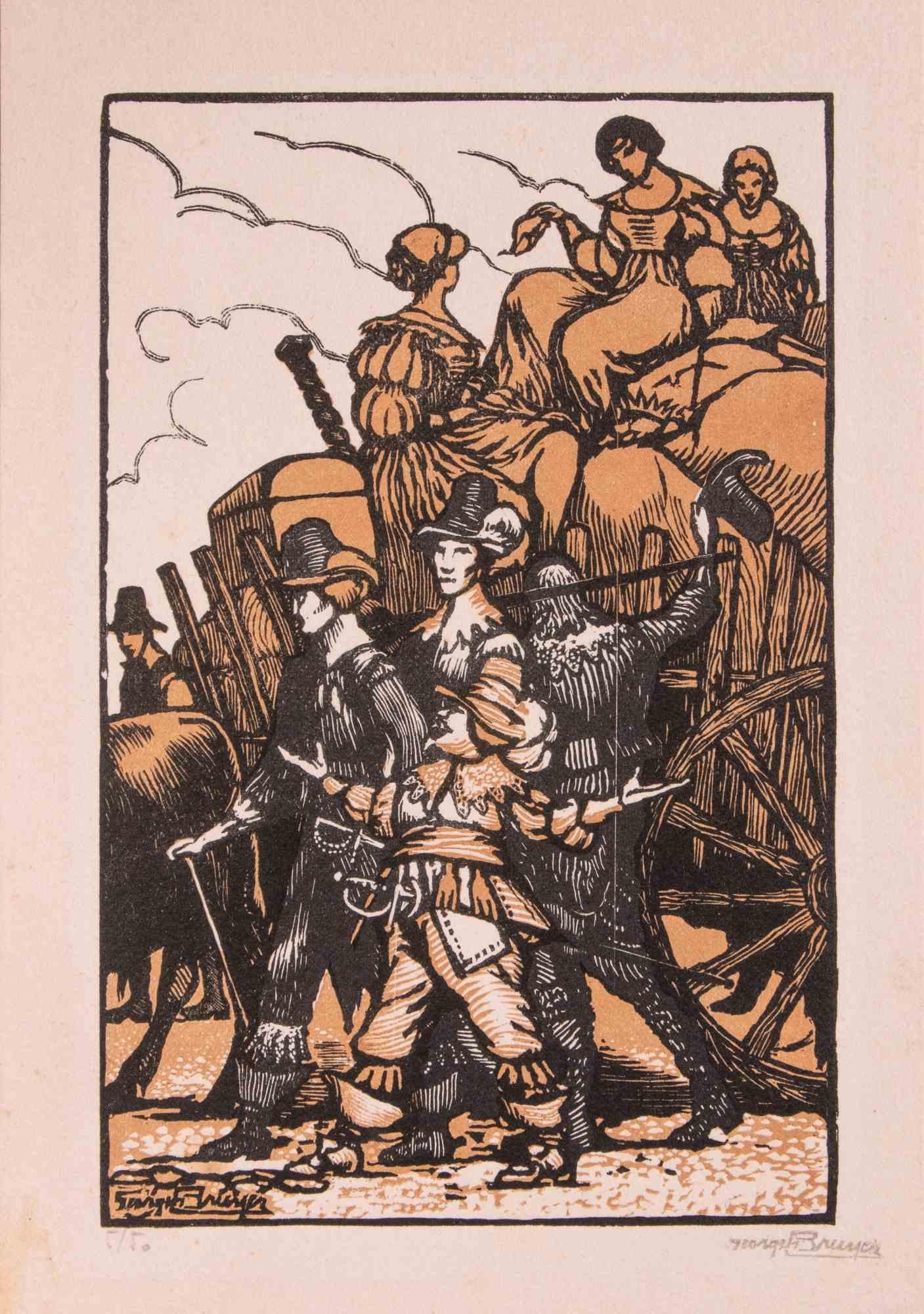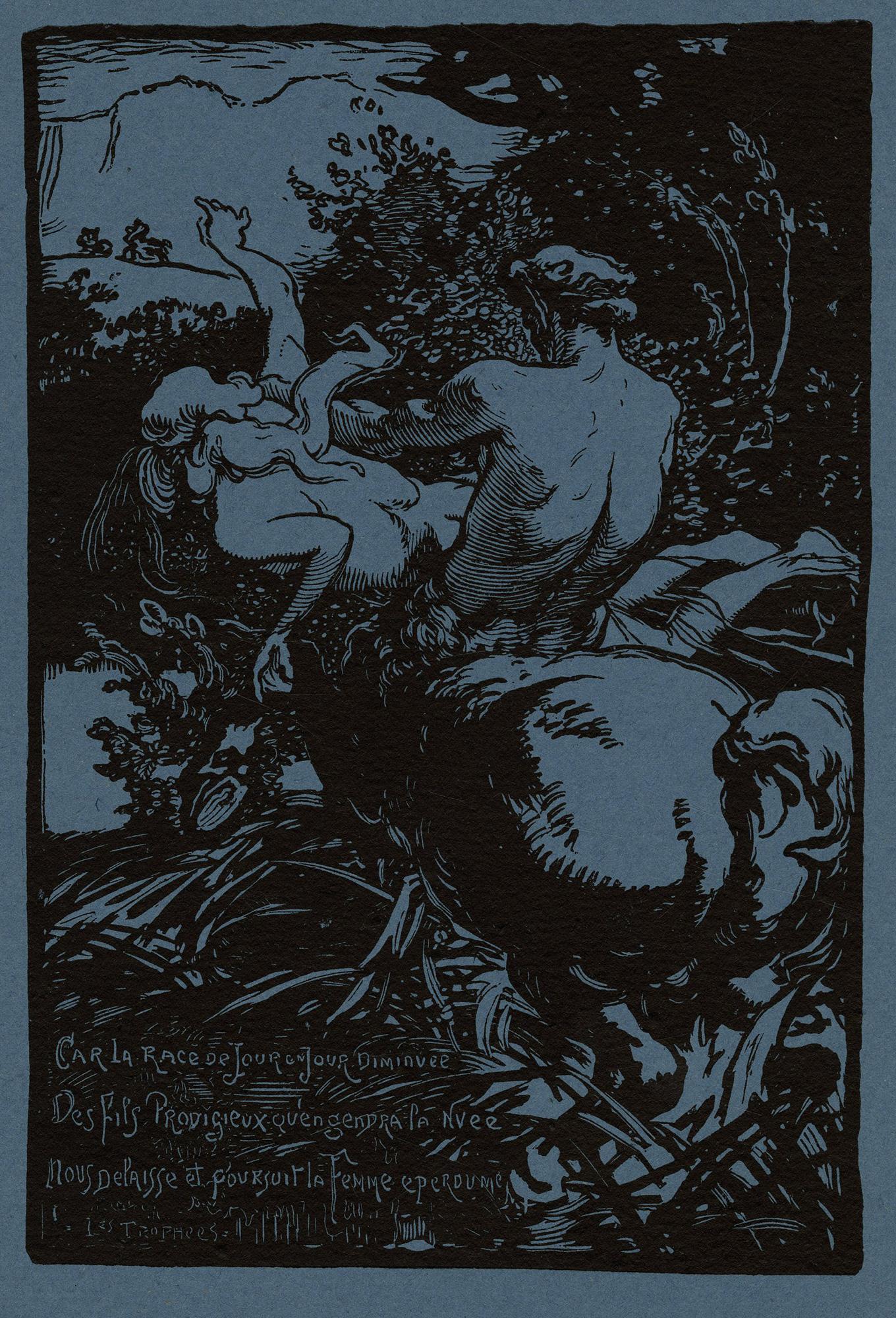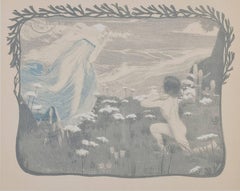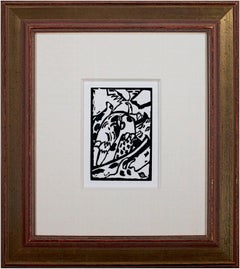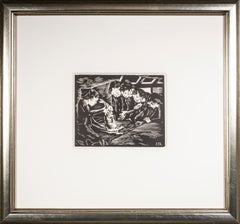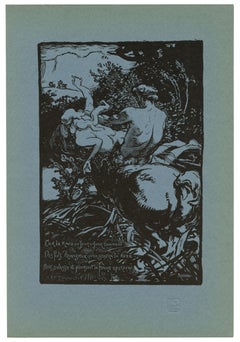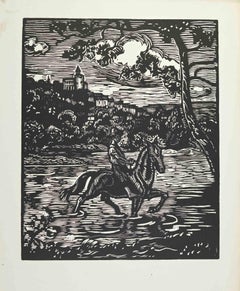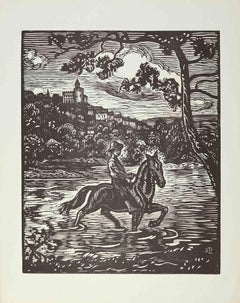Items Similar to "Car La Race, Became the Race..., " Woodcut on Blue Paper by Louis Lepere
Want more images or videos?
Request additional images or videos from the seller
1 of 10
Auguste Louis Lepère"Car La Race, Became the Race..., " Woodcut on Blue Paper by Louis Lepere1890
1890
$500
£382.83
€438.60
CA$713.48
A$780.89
CHF 405.91
MX$9,398.31
NOK 5,102.95
SEK 4,786.73
DKK 3,276.07
About the Item
"Car La Race" is an original woodcut on blue paper by Louis Auguste LePere. It depicts a centaur capturing a nude human woman in a flurry of motion and muscle.
16" x 13 3/8" art
16 7/8" x 14 1/4" frame
Auguste-Louis Lepère (Paris, November 30, 1849 - Domme, November 20, 1918) was a French painter and etcher. Auguste Lepère is also considered the leader in the creative revival of wood engraving in Europe.
He was apprenticed at the age of thirteen to the English wood engraver Joseph Burn Smeeton who established his studio in Paris. Lepère desired foremost to be a painter and submitted his paintings to the annual Salons but he worked for thirty years as an illustrator, earning his livelihood producing wood engraving illustrations for L'Art, Monde illustré, La Revue illustrée and L'Illustration.
Lepère continued working with the wood matrix, the blocks facile in the hands of this master, producing individual wood engravings. Between 1889 and 1901, his favorite subjects were the urban scenes around contemporary Paris—the bridges, cathedrals and boulevards.
- Creator:Auguste Louis Lepère (1849-1918, French)
- Creation Year:1890
- Dimensions:Height: 16.875 in (42.87 cm)Width: 14.25 in (36.2 cm)
- Medium:
- Movement & Style:
- Period:
- Condition:
- Gallery Location:Milwaukee, WI
- Reference Number:Seller: 7102g1stDibs: LU60532571463
About the Seller
4.9
Gold Seller
Premium sellers maintaining a 4.3+ rating and 24-hour response times
Established in 1966
1stDibs seller since 2017
451 sales on 1stDibs
Typical response time: 2 hours
- ShippingRetrieving quote...Shipping from: Milwaukee, WI
- Return Policy
Authenticity Guarantee
In the unlikely event there’s an issue with an item’s authenticity, contact us within 1 year for a full refund. DetailsMoney-Back Guarantee
If your item is not as described, is damaged in transit, or does not arrive, contact us within 7 days for a full refund. Details24-Hour Cancellation
You have a 24-hour grace period in which to reconsider your purchase, with no questions asked.Vetted Professional Sellers
Our world-class sellers must adhere to strict standards for service and quality, maintaining the integrity of our listings.Price-Match Guarantee
If you find that a seller listed the same item for a lower price elsewhere, we’ll match it.Trusted Global Delivery
Our best-in-class carrier network provides specialized shipping options worldwide, including custom delivery.More From This Seller
View All'Hyde Park' original woodcut engraving signed by Auguste Louis Lepère
By Auguste Louis Lepère
Located in Milwaukee, WI
The present artwork is an excellent example of the woodcut engravings of Auguste-Louis Lepère (1849 - 1918). He was the son of the sculptor Francois Lepère, a...
Category
1860s Realist Figurative Prints
Materials
Woodcut, Engraving
"H. L'Illusion (L'Estampe Moderne I), " Color Lithograph
By Henri Bellery-Desfontaines
Located in Milwaukee, WI
"H. L'Illusion (L'Estampe Moderne I)" is an original color lithograph by Henri Bellery-Desfontaines. This piece depicts a nude child before a dream-like woman in a blue translucent robe. This piece was published in the French Art Nouveau publication L'Estampe Moderne. Signed in plate.
15 3/4" x 12" art
Henri Bellery-Desfontaines , born with Paris in 1867 and dead the October 6th 1909, is a French Noveau artist Jack-of-All- Trades, who produced tables, illustrations, posters, lithographies, drawings of carpet, pieces of furniture and banknotes, and even dabbled with decoration & architecture.
In the 1900s, Paris was the perfect place for a group of young artists influenced by artistic currents like neogothic style or symbolism. Most of them started as painters and they switched later to decorative arts, attracted by the idea of an ever-present art, a lifeless art, a total art. Henri Bellery-Desfontaines was a member of this group and he started as as painter in Pierre-Victor Galland’s atelier. He entrusted him the decorative motifs which would frame Panthéon de Paris' drawings: Maillot, Bonnat, Humbert and specially Jean-Paul Laurens, who proposed him to join his atelier in l’École des Beaux-Arts de Paris. With him, he decorated l'Hôtel de Ville de Paris or Le Salon Lobau, Henri Bellery-Desfontaines is thought to have Luc-Olivier Merson (1846-1920) as a teacher.
During his years as a student, he started to illustrate magazines and books of tales and in 1895, Bellery-Desfontaines opted rapidly for illustration, probably due to financial problems, and he participated in magazines such as L’Image, L’Estampe Moderne or L’Almanach des Bibliophiles. This year, the Salon des Artistes Français hosted one of his design of tapestry.
From 1900 on, he gradually evolved toward an ambitious decorative artist, making tapestries and furniture for rich leaders and patrons. Bellery-Desfontaines was an important artist of his epoch, and he took part in numerous events like Bal de...
Category
1890s Art Nouveau Figurative Prints
Materials
Lithograph
'Improvisation 7' original first ed. woodcut from 'Klänge' by Wassily Kandinsky
By Wassily Kandinsky
Located in Milwaukee, WI
The present woodcut print comes from 'Klänge (Sounds),' a book of original graphics and poetry by Wassily Kandinsky. This first edition was released in an edition of 300, each book signed and numbered by the artist. The title of the album and this particular print, 'Improvisation,' demonstrated Kandinsky's interest in music and how abstract musical forms could be translated into images on a two-dimensional surface. This particular composition is difficult to read, but through the abstraction, one can make out various figures and a landscape beyond.
7.5 x 5 inches, image
22 x 19.5 inches, frame
Woodcut in black ink on laid paper (watermark Van Gelder Zonen)
Signed with encircled 'K' in the block, lower right
Framed to conservation standards using 100 percent acid free archival materials including silk-lined matting with 1/4 inch bevel, museum glass, and a gold-gilded moulding
Ref. Roethel 124
The Museum of Modern Art described 'Klänge (Sounds)' as follows:
Vasily Kandinsky's self-described "musical album," Klänge (Sounds), consists of thirty-eight prose-poems he wrote between 1909 and 1911 and fifty-six woodcuts he began in 1907. In the woodcuts Kandinsky veiled his subject matter, creating increasingly indecipherable images (though the horse and rider, his symbol for overcoming objective representation, runs through as a leitmotif). This process proved crucial for the development of abstraction in his art. Kandinsky said his choice of media sprang from an "inner necessity" for expression: the woodcuts were not merely illustrative, nor were the poems purely verbal descriptions. Kandinsky sought a synthesis of the arts, in which meaning was created through the interaction of, and space between, text and image, sound and meaning, mark and blank space. The experimental typography shows his interest in the physical aspects of the book.
Klänge is one of three major publications by Kandinsky that appeared shortly before World War I, alongside Über die Geistige in der Kunst (Concerning the Spiritual in Art) and the Blaue Reiter almanac...
Category
1910s Blue Rider Abstract Prints
Materials
Woodcut
'The Rabbit' original woodcut engraving by Clarice George Logan
By Clarice George Logan
Located in Milwaukee, WI
In 'The Rabbit,' Wisconsin artist Clarice George Logan presents the viewer with a multi-figural scene: under a wood-frame structure, four children crouch on the ground, gathered around a young woman who presents a rabbit. Under normal circumstances, such an image of children with a bunny would recall childhood storybooks. In this case, however, the image is more ambiguous and suggests the unfortunate economic circumstances many children suffered during the interwar years. Nonetheless, the group could also be interpreted as a nativity play, with the rabbit taking the place of the Christ child, shining light on the children like in a painting by the Italian Renaissance artist Correggio. The careful line-work of the woodblock engraving adds a sense of expressionism to the scene, leaving the figures looking distraught and dirty, though the image nonetheless falls into the Social Realist category that dominated American artists during the Great Depression.
This print was published in 1936 as part of the Wisconsin Artists' Calendar for the year 1937, which included 52 original, hand-made prints - one for each week of the year.
Clarice George Logan was born in Mayville, New York in 1909 but moved to Wisconsin in 1921. She attended the Milwaukee State Teachers College from 1927 to 1931 where she studied with Robert von...
Category
1930s American Modern Figurative Prints
Materials
Engraving, Woodcut
'Improvisation 7' second ed. woodcut from 'Klänge' by Wassily Kandinsky
By Wassily Kandinsky
Located in Milwaukee, WI
'Improvisation 7' second ed. woodcut from 'Klänge' is a woodcut print created by Wassily Kandinsky. The present woodcut print comes from the second edition of 'Klänge (Sounds),' a book of original graphics and poetry by Wassily Kandinsky. The title of the album and of this print, 'Improvisation,' demonstrated Kandinsky's interest in music and how abstract musical forms could be translated into images on a two-dimensional surface. This particular composition is difficult to read, but through the abstraction, one can make out various figures and a landscape beyond. Originally carved and printed in 1911, this second edition print was done ca. 1938. It is a woodcut in black ink on woven paper. Signed with encircled 'K' in the block, lower right (from the book, signed in ink, ed. 117/300)
Image Size: 7 1/2" x 5 inches
Frame Size: 22 1/4" x 18 3/4"
Ref. Roethel 124
Artist Bio:
The Museum of Modern Art described 'Klänge (Sounds)' as follows:
Vasily Kandinsky's self-described "musical album," Klänge (Sounds), consists of thirty-eight prose-poems he wrote between 1909 and 1911 and fifty-six woodcuts he began in 1907. In the woodcuts Kandinsky veiled his subject matter, creating increasingly indecipherable images (though the horse and rider, his symbol for overcoming objective representation, runs through as a leitmotif). This process proved crucial for the development of abstraction in his art. Kandinsky said his choice of media sprang from an "inner necessity" for expression: the woodcuts were not merely illustrative, nor were the poems purely verbal descriptions. Kandinsky sought a synthesis of the arts, in which meaning was created through the interaction of, and space between, text and image, sound and meaning, mark and blank space. The experimental typography shows his interest in the physical aspects of the book.
Klänge is one of three major publications by Kandinsky that appeared shortly before World War I, alongside Über die Geistige in der Kunst (Concerning the Spiritual in Art) and the Blaue Reiter almanac...
Category
1910s Blue Rider Abstract Prints
Materials
Woodcut, Laid Paper
"Le Passant, " Original Color Lithograph
By Robert Engels
Located in Milwaukee, WI
"Le Passant" is an original Art Nouveau color lithograph. It depicts two women in the foreground wearing medieval white robes and a knight passing behind them on a black horse. Features the L'Estampe Moderne blindstamp bottom right hand corner. 1898.
15 3/4" x 12" art
23" x 19 1/4" framed
Robert Engels studied in Dusseldorf and moved shortly thereafter to work in Munich. Later, he became a professor at a school of applied arts at the KGS in Munich. He created many decorative prints as well as stained glass windows and also created compositions to illustrate Joseph Bedier's rendition of "Tristan and Iseult...
Category
1890s Art Nouveau Figurative Prints
Materials
Lithograph
You May Also Like
"Le centaure" original woodcut
By Auguste Louis Lepère
Located in Henderson, NV
Medium: original woodcut. This impression on blue-green paper was printed in 1902 and published in London by The Studio. Image size: 8 x 5 1/2 inches (205 x 140 mm). The Studio dryst...
Category
Early 1900s Expressionist Figurative Prints
Materials
Woodcut
"Le centaure" original woodcut
By Auguste Louis Lepère
Located in Henderson, NV
Medium: original woodcut. This impression on thin wove paper was printed in 1902 and published by Gazette des Beaux Arts. Image size: 8 1/8 x 5 1/2 inches (207 x 140 mm). Signed in t...
Category
Early 1900s Expressionist Figurative Prints
Materials
Woodcut
The Ride - Woodcut by Paul Emile Colin - 1930 ca.
Located in Roma, IT
Woodcut print realized by Paul Emile Colin in 1930s.
Monogrammed in the plate.
Very good condition.
Category
1930s Modern Figurative Prints
Materials
Woodcut
The Ride - Woodcut by Paul Emile Colin - 1930 ca.
Located in Roma, IT
Woodcut print realized by Paul Emile Colin in 1930s.
Monogrammed in the plate.
Very good condition.
Category
1930s Modern Figurative Prints
Materials
Woodcut
The Migration - Woodcut Print by Georges Bruyer - Early 20th Century
Located in Roma, IT
The Migration is an original artwork realized by Georges Bruyer (1883-1962. Original woodcut print on paper, realized on early-20th century, hand signed in pencil by the artist on t...
Category
Early 20th Century Modern Figurative Prints
Materials
Woodcut
Les Trophées
By Auguste Lepère
Located in Middletown, NY
London: The Studio, 1898.
Wood engraving on blue wove paper, 8 x 5 3/8 inches (202 x 137 mm), full margins. As published in The Studio, Volume 12, 1898, with the blindstamp in the l...
Category
Late 19th Century French School Portrait Prints
Materials
Handmade Paper, Woodcut
More Ways To Browse
Pierre Etienne Moitte
Piranesi Prints Carceri
Pop Shop 1
Poster Mardi Gras
Raoul Dufy Horse Lithograph
Raoul Dufy Lithograph Ascot
Rare Album Covers
Renato Guttuso On Sale
Rene Magritte Etching
Rene Quillivic
Renoir Maternite
Retour Magritte
Retro Spoleto Posters
Richard Lindner Collage
Robert Longo Cindy
Roy Lichtenstein Thinking Of Him
Ruth Waddy
Sadao Watanabe. On Sale
